
 |
|
|
IWith the composition "The Spiritual Location of Sound" I would like to indicate some relations that exist between a specific loudspeaker set-up and the composition created for it. I would like to describe how the possibility of three-dimensional movement of sound in space has shaped my compository thinking. But first I want to make a few general remarks on my working process. At the beginning of each composition, there is the design of the loudspeaker configuration. Each loudspeaker set-up represents an optimal matrix, along which a number of specific sound movements can be realized. In connection with the acoustic properties of the room, the first ideas for the compository concept emerge, setting out criteria for the selection of sound material. One of the primary conditions is that all the material for the composition has to be digitally available, so as to enable a digitally controlled synchronisation of tonal events and linked movement (see below). It is possible to "draw" virtual sound gestures on this loudspeaker-matrix.
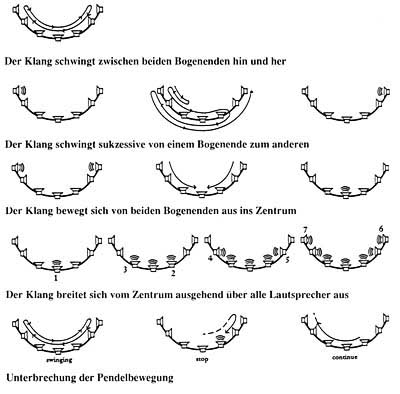 The movement of the sounds in the room becomes an important aspect in the perception of the music, controlling the evolution of the piece as a parameter on an equal footing with pitch, timbre or rhythm. I would now like to try and illustrate these general statements using examples from "The Spiritual Location of Sound".
IIDescription of the loudspeaker set-up and its relation to the architectural space. The music for "The Spiritual Location of Sound" was composed quite generally for a church room, a ritual room. The sound installation was designed for the nave of the Heiliggeistkirche in Heidelberg, considering its specific dimensions. The set-up of the loudspeaker installation was inspired by the architecture of the nave. The gothic arches constitute central points for the positioning of the main elements of the installation.
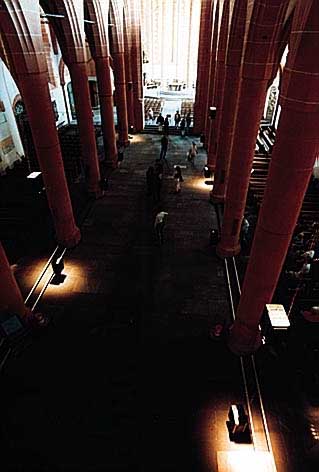
The installation for the Heiliggeistkirche consists of two principal components. Firstly, four inter-related "sound columns" (fig.1, A-D), each made up of three loudspeakers suspended from chains. The second component is formed by eight loudspeakers hanging 50 cm above the floor (fig.1, 1-8). The intermediate floors of the nave determine the maximum height of the installation (14 m). The surface of the installation is based upon the dimensions of the central aisle (28 x 7 m).

fig.1 Description of the first main component - the "sound columns" The four vertical sound chains have identical proportions. The loudspeaker boxes are arranged in three levels on top of each other. The upper level is fourteen meters high. The chains are arranged in a zig-zag pattern. The distance between the suspended loudspeakers is not always the same. By positioning level II a little closer to the recipients, the human ear is allowed to more readily perceive sound events taking place on level I and II (fig. 1).
Description of the second main component - the 8-part horizontal level III This is the level that is closest to the visitor. It structures the depth of the room, i.e, its surface more precisely than levels I and II, as the loudspeakers are two times closer to each other. It is now technically possible to draw a legato line (fig.2, rotation on level III), and the sound can circle around the listener in a continuous movement.
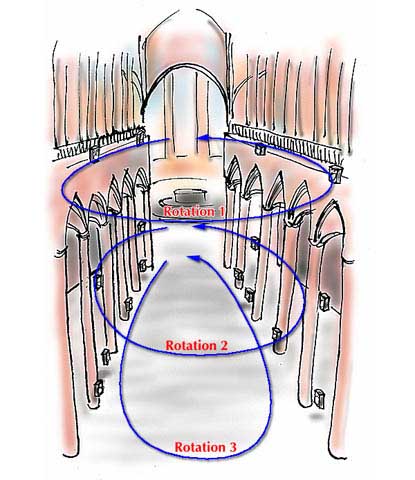 fig.2
IIIOptional movements of the loudspeaker set-up and their connection to the compository process. In the following, some basic movements are described that are specific to the installation "The Spiritual Location of Sound".
1
2Another large movement was created by exchanging sounds between the diagonally opposed chains A and C (fig.1). The sound is heard on all three loudspeakers of the respective chain. I used this kind of movement in two parts of the composition, although combined with different sound material, creating very different acoustic atmospheres and sound impressions. In one case I used a rather homogenous sound tape with a constant pitch. The large and spacious movement of the sounds create a signal-like sound gesture, introducing the transition to the next part of the composition. One might associate a fierce "back and forth" movement of the sound. In the other case, percussion sound changes position between the chains. The listener can only perceive the sound on the chain he is standing next to. (fig.3.I). When he approaches the opposing chain, he hears the sound emitted there more clearly. When he is in the middle of the diagonal, he will hear both sounds simultaneously (fig.3.II). As he further approaches the other chain, the original sound fades away and the complementary rhythm is revealed (s. fig.3.III).
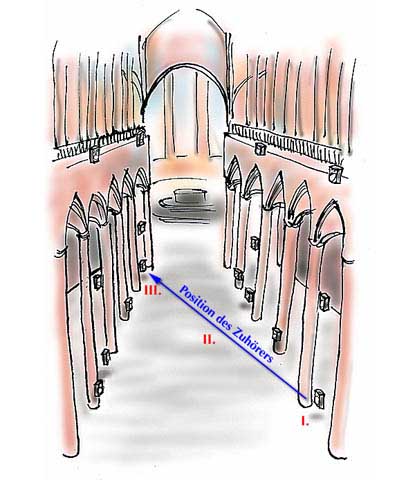 fig.3
 fig.4 The score for passing along the loudspeaker diagonal is the following:
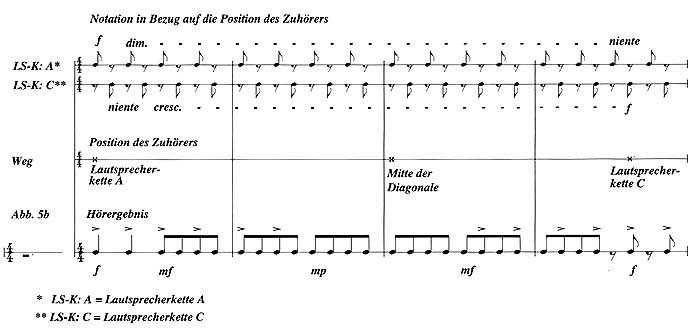
fig.5
3
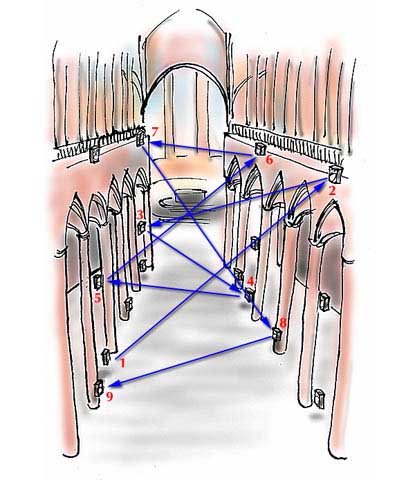 fig.6
 fig.7: scored rhythm which movement is depicted in fig.6
4
There are many more examples, as there are many different ways to integrate movement of sound in musical composition. The room, that has always had an intermediary function, is gradually converted into an active participant - because of its architectural dimensions and acoustic properties. It is converted into the resounding body of the installation.
|